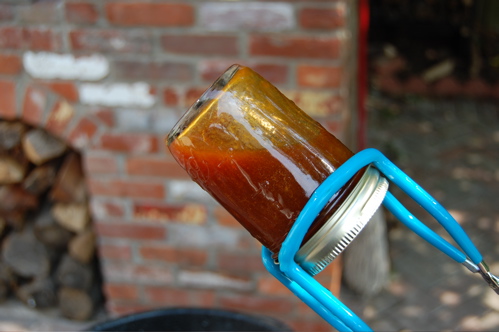A Canning Primer

It was not so very long ago that canning was commonplace enough that most people had at least seen it done. That’s not true anymore, hence this little photo-primer. Like my jam-making instructions, there’s no recipe included here, though the procedures apply to pretty much any recipe that calls for a boiling water canner. Which is to say things like jams, jellies, whole fruit preserves, tomato sauces and most relishes…the so-called “acid” foods. “Non-acid” foods, things like whole vegetables and meat sauces, are canned according to an entirely different method requiring a pressure canner. I don’t do any of that, preferring to leave it to the pro’s. As for any recipe that you intend to can, make sure it comes from a reputable source, and follow all instructions to the letter.
In general, here’s how the boiling water canner procedure goes. Start by determining how many jars you’ll need, then wash them thoroughly in hot soapy water. A dishwasher works great for this.

Arrange them on a rack just to the side of the stove where you’re making your whatever-it-is.

Put your lids on to simmer very gently in a small sauce pan. The idea here is to have the lids as sanitized as possible without boiling them per se. Vigorous boiling can damage the rubber on the undersides of the lids and ruin your seal.

When your jam, butter, relish or chili sauce is ready, ladle it into the waiting jars, leaving 1/4-inch space at the top. Looks messy dunnit? It is.

Once all the jars have been filled, go around to each one with a clean paper towel and wipe away any residues, bits of fruit or seeds that might interfere with a good seal.

Using your little magnetic canning wand, pluck a lid out of the hot water and and place it on top of the jar.

Once that’s done, put on the ring and screw it down onto the jar. Once it’s all the way on, the general rule of thumb is to give the ring one good firm twist to tighten it. Don’t go nuts with this since you don’t want to bend the threads on the ring (though you probably won’t be able to hold the jar long enough to put that kind of muscle into it…the things are hot with preserves inside).

Packed jars at the ready, proceed to your canner. Mine I put on a propane-fueled burner on the patio. Why? Firstly because I have a glass-topped electric range which can’t support the weight of a canner. Second, because the burner puts out something like 36,000 BTU’s of heat. Wide open, it’ll bring a full canner’s worth of water to the boil in about 15 minutes. Third, because canning outdoors makes me feel like a true-blue old school Kentuckian.

So then, with the water at full boil and the rack raised, I put in my packed jars, being careful to insert them in order at the 12:00, 5:00, 10:00, 4:00, 7:00 and 2:00 positions. You can put one in the middle after that if you wish. Why be so uptight about the loading sequence? Because the wire rack isn’t terribly stable. You want the thing as balanced as possible at all times to avoid a tip-up, splashing and a potential cracking of the jars should they crash against the bottom of the canner.

Using oven mits or kitchen towels, lower the rack into the canner and release the handles, which will then fall in.

Cover the canner with the lid and keep the jars immersed for as long as the recipe stipulates. Remember that a minute in the canner only counts so long as the water is boiling. I don’t have a problem with my canner water cooling down, due to the heat of the burner. However most home canners will take a minute or to to recover once the jars are put in.
When time is up, take off the top and either a) raise up the rack or b) just reach in with your jar graspers and fish out the jars, as I’m doing here. Pick up the jars one by one…

…let the hot water drain off, then up-end each jar to give the inside of lid one last dose of heat (I don’t know if this is strictly necessary anymore, but it’s the way the old-schoolers did it).

Set the jar down in a place where you won’t have to move it until the next day and…you’re done! Over the next several hours you’ll hear the pink, ponk of the lids being sucked in by the vacuum environments in the jars. It is a most satisfying sound, I can tell you. The following day, check all the tops by pressing down on them firmly with your finger. If there’s any give to them at all, you’ve got a bad seal. No matter…eat it! Or pass it along to a friend or neighbor as a factory reject. They’ll love you for it, I promise.
Water bath processing is not necessary for jams, jellies or chutneys. The US is the only country in the world that thinks that these home preserves need further processing. There is enough sugar and or vinegar in these to keep them safe for consumption unless the jam/jelly is low in sugar and then it needs refrigeration, not canning.
True, but we also have some of the world’s lowest rates of food borne illness! 😉
I personally would never advocate keeping jams, jellies or chutneys at room temperature without them being canned, but when I don’t feeling like going through the process I’ll do refrigerator or freezer versions which keep well with minimum hassle.
Cheers and thanks for the comment!
– Joe